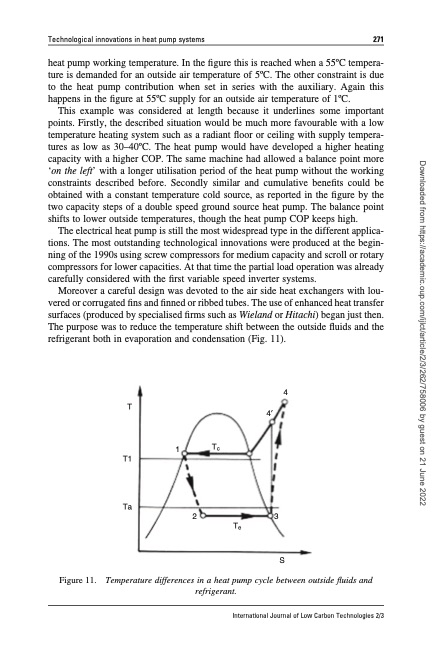
PDF Publication Title:
Text from PDF Page: 010
Technological innovations in heat pump systems 271 heat pump working temperature. In the figure this is reached when a 55oC tempera- ture is demanded for an outside air temperature of 5oC. The other constraint is due to the heat pump contribution when set in series with the auxiliary. Again this happens in the figure at 55oC supply for an outside air temperature of 1oC. This example was considered at length because it underlines some important points. Firstly, the described situation would be much more favourable with a low temperature heating system such as a radiant floor or ceiling with supply tempera- tures as low as 30–40oC. The heat pump would have developed a higher heating capacity with a higher COP. The same machine had allowed a balance point more ‘on the left’ with a longer utilisation period of the heat pump without the working constraints described before. Secondly similar and cumulative benefits could be obtained with a constant temperature cold source, as reported in the figure by the two capacity steps of a double speed ground source heat pump. The balance point shifts to lower outside temperatures, though the heat pump COP keeps high. The electrical heat pump is still the most widespread type in the different applica- tions. The most outstanding technological innovations were produced at the begin- ning of the 1990s using screw compressors for medium capacity and scroll or rotary compressors for lower capacities. At that time the partial load operation was already carefully considered with the first variable speed inverter systems. Moreover a careful design was devoted to the air side heat exchangers with lou- vered or corrugated fins and finned or ribbed tubes. The use of enhanced heat transfer surfaces (produced by specialised firms such as Wieland or Hitachi) began just then. The purpose was to reduce the temperature shift between the outside fluids and the refrigerant both in evaporation and condensation (Fig. 11). Figure 11. Temperature differences in a heat pump cycle between outside fluids and refrigerant. T T1 Ta 4 4′ 1 Tc 23 Te S International Journal of Low Carbon Technologies 2/3 Downloaded from https://academic.oup.com/ijlct/article/2/3/262/758006 by guest on 21 June 2022PDF Image | Technological innovations in heat pump systems

PDF Search Title:
Technological innovations in heat pump systemsOriginal File Name Searched:
2-3-262.pdfDIY PDF Search: Google It | Yahoo | Bing
CO2 Organic Rankine Cycle Experimenter Platform The supercritical CO2 phase change system is both a heat pump and organic rankine cycle which can be used for those purposes and as a supercritical extractor for advanced subcritical and supercritical extraction technology. Uses include producing nanoparticles, precious metal CO2 extraction, lithium battery recycling, and other applications... More Info
Heat Pumps CO2 ORC Heat Pump System Platform More Info
| CONTACT TEL: 608-238-6001 Email: greg@infinityturbine.com | RSS | AMP |